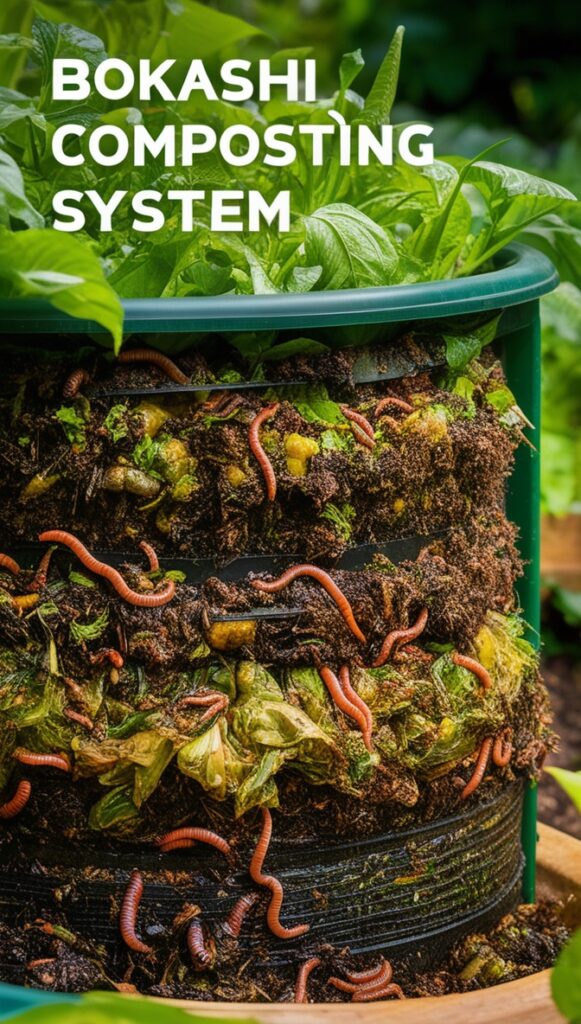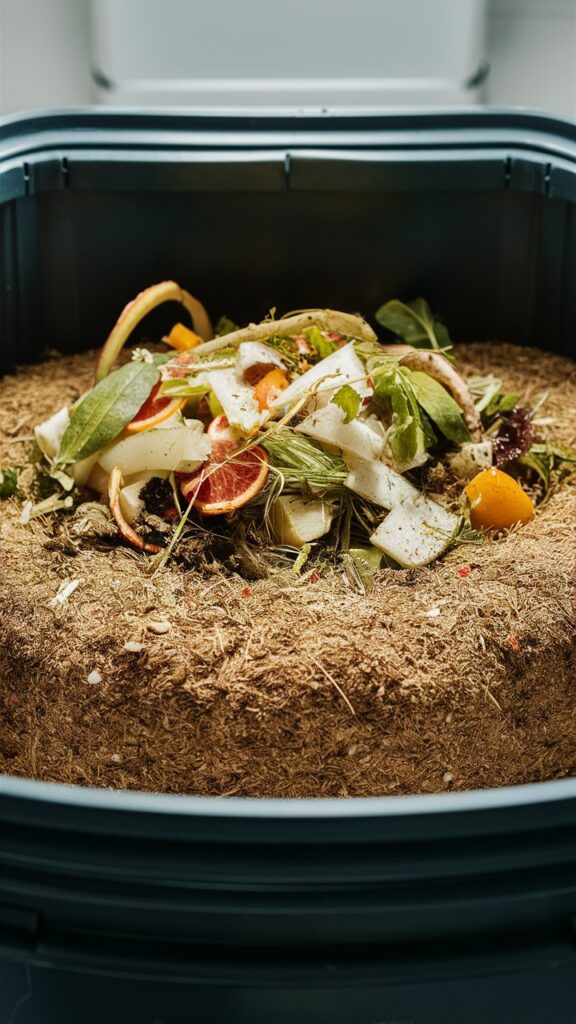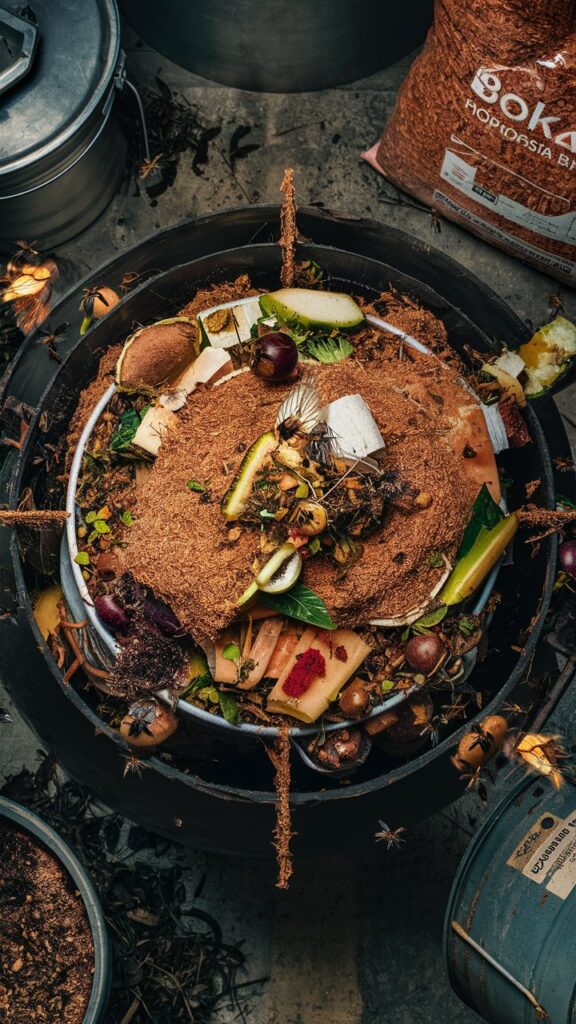Composting has always been a fascinating process for me, transforming kitchen waste into rich, valuable compost for the garden. Among the various methods available, Bokashi composting stands out for its unique approach and numerous benefits and is a great method for beginners too!.
Unlike traditional composting, which relies on decomposition, Bokashi composting uses fermentation.
Bokashi composting is particularly friendly for beginners and suitable for urban settings.
This method is beneficial for several reasons. It’s faster than traditional composting, doesn’t produce unpleasant odors, and can compost a wider range of kitchen scraps, including meat and dairy. Plus, it produces a nutrient-rich “tea” that can be used as a powerful liquid fertilizer for plants.
I remember the first time I heard about Bokashi composting from a fellow gardening enthusiast. I was a bit skeptical at first—fermentation sounded more like something you’d do to make pickles, not compost!
But my curiosity got the better of me, and I decided to give it a try. It was a decision that transformed my composting habits and my garden.
What is Bokashi Composting?

Bokashi composting is a method that originated in Japan. The word “Bokashi” means “fermented organic matter” in Japanese. This process involves layering kitchen scraps with a special bran that contains beneficial microbes.
These microbes ferment the scraps, breaking them down without producing the typical composting odors.
The science behind Bokashi is quite fascinating. Unlike traditional composting, which relies on aerobic (oxygen-dependent) bacteria to decompose organic matter, Bokashi uses anaerobic (oxygen-free) fermentation.
This means you don’t need to worry about turning your compost or dealing with a smelly pile in your backyard.
Initially, the concept of fermentation confused me. I thought fermentation was only for food like yogurt or kimchi. But after a few attempts and a lot of reading, I realized it’s a simple and efficient way to handle kitchen waste.
How to Start an Organic Kitchen Garden
Getting Started with Bokashi Composting
Starting with Bokashi composting is quite simple, and you have two options: make your Bokashi bin at home or buy a ready-made kit from Amazon.
Essential Materials and Tools Needed:
- Bokashi bucket with an airtight lid
- Bokashi bran
- Kitchen scraps
Option 1: DIY Bokashi Bin
You can make your Bokashi bin at home with a few basic materials. You’ll need a couple of plastic buckets, one with a tight-fitting lid, and a tap for draining the liquid. Drill small holes in the bottom of the inner bucket to allow the liquid to drain into the outer bucket.
Option 2: Purchasing a Bokashi Kit
If DIY isn’t your thing, you can easily find Bokashi kits on Amazon. These kits come with everything you need, including the bucket, lid, and bran. While this option might be more expensive, it saves you the hassle of sourcing materials and setting up the system.
Pros and Cons:
- DIY: Cost-effective but requires some effort to set up.
- Ready-made Kit: More convenient but comes at a higher price.
I remember struggling to find a suitable bucket for my DIY Bokashi bin. This was many years back, and at that time, there weren’t any options to purchase online.
After much searching, I ended up repurposing an old paint bucket. It worked, but looking back, buying a ready-made kit would have saved me a lot of time and effort.
How to Use Your Bokashi Bin
Once you have your Bokashi bin ready, using it is straightforward. Here’s a step-by-step guide to help you get started:
- Add Kitchen Scraps: Begin by adding your kitchen scraps to the bin. These can include fruit and vegetable peels, coffee grounds, tea bags, cooked and raw meat, and dairy products.
- Layer with Bokashi Bran: After adding a layer of scraps, sprinkle a handful of Bokashi bran over them. This bran contains the essential microbes needed for fermentation.
- Compress and Seal: Compress the scraps to remove as much air as possible, then seal the bin tightly to maintain the anaerobic environment.
- Repeat: Continue this process until the bin is full, layering scraps and bran each time.
Maintaining the Right Conditions:
- Temperature: Keep the bin in a warm place, ideally between 20-25°C.
- Moisture: Ensure the contents are not too wet or dry. Proper moisture is crucial for effective fermentation.
I once accidentally added a plastic wrapper to the bin. It took a while to fish it out, and my family had a good laugh about it. It taught me to be more careful about what I put in the bin.
What to Compost in a Bokashi Bin

One of the great things about Bokashi composting is its flexibility with kitchen scraps. However, there are some guidelines to follow for the best results.
Suitable Items:
- Fruit and vegetable scraps
- Coffee grounds and tea bags
- Cooked and raw meat
- Dairy products
- Bread and grains
Items to Avoid:
- Large bones
- Excessive liquids
- Plastic and metal
Tips for Preparation:
Cutting your scraps into smaller pieces can speed up the fermentation process. This is particularly useful for tougher items like citrus peels or meat.
I once tried composting a whole pumpkin. It didn’t ferment well until I cut it into smaller pieces. Lesson learned: smaller is better!
Managing Your Bokashi Bin
Proper management of your Bokashi bin ensures smooth operation and effective composting. Here are some tips:
Handling Odors:
- Good Smells: A slight pickled smell is normal.
- Bad Smells: If you notice a foul odor, it could mean something is wrong. Check for any non-compostable items and adjust the moisture levels.
Troubleshooting Common Issues:
- Mold: A white, fuzzy mold on top is normal and indicates good fermentation. Green or black mold, however, is a sign of trouble.
- Excess Liquid: Regularly drain the Bokashi tea to prevent oversaturation.
Importance of Draining the Bokashi Tea:
The liquid produced, known as Bokashi tea, is a powerful fertilizer. Dilute it with water (1:100 ratio) before using it on your plants.
I once forgot to drain the Bokashi tea for a week! The smell when I finally did was unforgettable, and not in a good way! Now, I set a reminder to do it regularly.
Using Bokashi Compost in Your Garden
Once your Bokashi bin is full and has fermented for about two weeks, it’s time to use the pre-compost in your garden.
Burying Bokashi Pre-Compost:
- Dig a trench or hole about 20-25 cm deep in your garden.
- Spread the Bokashi pre-compost evenly and cover it with soil.
- Wait another two weeks before planting to allow for complete decomposition.
Benefits for Soil Health:
Bokashi compost enriches the soil with beneficial microbes and nutrients, promoting healthier plant growth.
Integrating into Your Garden Routine:
Use the pre-compost in different areas of your garden, rotating where you bury it to maximize soil health across your space.
The first time I used Bokashi compost in my garden, the plants grew lush and green. My husband joked that we’d need a machete to get through the “jungle” in our backyard!
Pros & Cons of Bokashi Composting
Bokashi composting has its advantages and disadvantages, making it important to consider both before starting.
Pros:
- Faster composting process
- Can compost a wider variety of kitchen scraps
- Produces nutrient-rich compost and liquid fertilizer
- Less odor and pest issues compared to traditional composting
Cons:
- Cost of Bokashi bran
- Managing the Bokashi tea
- Initial setup, especially for DIY bins
I was thrilled with how quickly the Bokashi system produced compost, but managing the Bokashi tea was a bit of a chore at first. Once I got the hang of it, though, it became just another part of my gardening routine.
Comparison with Other Composting Methods
Bokashi composting is just one of many composting methods that I have used. Here’s a comparison with traditional composting and vermicomposting to help you decide which method suits your needs best.
Traditional Composting
Traditional composting involves collecting organic waste in a pile or bin, where it decomposes over time. This method requires a balance of green (nitrogen-rich) and brown (carbon-rich) materials, regular turning to aerate the pile, and can take several months to a year to produce compost.
Pros:
- Ideal for those with ample outdoor space
- Produces large amounts of compost over time
Cons:
- Slow process, taking months to a year
- Requires regular maintenance and turning
- Can produce unpleasant odors
Vermicomposting
Vermicomposting uses worms to break down organic waste into nutrient-rich worm castings. It’s faster than traditional composting and produces high-quality compost. Vermicomposting is suitable for indoor use, making it a good choice for apartment dwellers.
Pros:
- Faster process than traditional composting
- Produces high-quality compost
- Suitable for indoor use
Cons:
- Requires some maintenance, such as keeping the worms healthy
- Might not be suitable for those squeamish about handling worms
Benefits of Using Vermicompost
Bokashi Composting
Bokashi composting uses anaerobic fermentation, meaning it works without oxygen. This method is faster, taking only a few weeks to produce pre-compost that can be buried in the garden to further decompose. It’s also less odor-prone and can handle a wider range of kitchen scraps, including meat and dairy.
Bokashi composting method is also suitable for beginners and those who live in apartments.
Pros:
- Faster process, taking only a few weeks
- Less odor compared to other methods
- Can handle a wider range of kitchen scraps
Cons:
- Initial setup cost for Bokashi bran and bins
- Requires managing the Bokashi tea
Which Composting Method to Choose?

Choosing the right composting method depends on your specific needs and circumstances:
- Traditional Composting: If you have ample outdoor space and don’t mind a slower process, traditional composting is a solid option.
- Vermicomposting: If you prefer a quicker process and don’t mind handling worms, vermicomposting is great, especially for indoor use.
- Bokashi Composting: For those looking for a fast, odor-free method that can be used indoors and handles a variety of kitchen scraps, Bokashi composting is ideal.
By understanding the pros and cons of each method, you can select the one that best fits your lifestyle and composting needs.
Initially, I was overwhelmed by the options. However, after trying all three, I found Bokashi composting to be the most convenient and effective for my urban garden.
However, I prefer Vermicomposting for my farm.
Bokashi Composting for Beginners – Yes or No?
Is Bokashi composting suitable for beginners? Here are some key points to consider:
Yes, Because:
- Easy to set up and maintain
- Less odor and faster results
- Can handle a variety of kitchen scraps
Considerations:
- Initial cost of materials or kits
- Learning to manage the Bokashi tea
- Requires a bit of space for the bin
Final Recommendation:
Bokashi composting is a great option for beginners due to its simplicity and efficiency. If you’re willing to invest a little time in understanding the process, it can be a rewarding way to manage kitchen waste and enrich your garden.
As a beginner, I found Bokashi composting much less intimidating than traditional methods. The learning curve was manageable, and the results were well worth it. My family was initially skeptical, but now they’re all onboard with our composting routine.
Benefits of Bokashi Composting
Bokashi composting offers numerous benefits that make it an attractive option for both beginners and experienced gardeners.
- Faster Composting Process: Bokashi composting can produce usable compost in as little as four weeks.
- Less Odor and Pest Issues: The fermentation process produces fewer odors, making it suitable for indoor use.
- Richer Compost for Your Garden: The resulting compost is packed with nutrients and beneficial microbes, enhancing soil health.
One day, my neighbor complimented me on how lush and green my garden looked. I proudly told her it was all thanks to Bokashi composting. I showed her my whole composting setup and she couldn’t believe how simple and effective it was!
Advanced Tips and Tricks
Once you’re comfortable with the basics of Bokashi composting, here are some advanced tips and tricks to optimize your process:
Seasonal Maintenance:
During colder months, fermentation can slow down. To keep your Bokashi bin active, store it in a warmer part of your home or use an insulating cover. In the summer, ensure the bin is kept out of direct sunlight to avoid overheating.
Troubleshooting Uncommon Issues:
Occasionally, you might encounter unusual problems like excessive mold or an overly wet bin. White mold is normal and a sign of healthy fermentation, but green or black mold indicates contamination. If your bin is too wet, add more Bokashi bran to absorb the moisture.
Maximizing Bokashi Tea:
Bokashi tea is a powerful liquid fertilizer. Dilute it at a ratio of 1:100 with water before using it on plants to avoid burning them. Use it within a few days of draining, as it’s most potent when fresh. You can also use Bokashi tea as a drain cleaner due to its beneficial microbes.
Layering for Optimal Fermentation:
For the best results, ensure you add a good mix of scraps and Bokashi bran. Avoid dumping large quantities of the same type of scrap in one go. Mixing vegetable peels, fruit scraps, and some meat or dairy helps maintain a balanced environment for fermentation.
Integrating Bokashi Compost with Traditional Methods:
If you already have a traditional compost pile, adding Bokashi pre-compost can boost its nutrient content and speed up decomposition. Just bury the fermented scraps in the middle of your pile.
During the winter, I keep my Bokashi bin in a sunny corner of my garden to maintain warmth. This simple trick helps keep the fermentation process on track despite the cold weather.
In extreme winters, it can be challenging for about a week to ten days, but since our winters are now shorter and less severe, it’s a manageable issue.
Conclusion
Bokashi composting is an excellent method for efficiently managing kitchen waste and producing rich compost for your garden.
Even beginners will find Bokashi composting to be a simple and effective solution for reducing household waste.
I encourage you to give Bokashi composting a try. Whether you choose to make your own bin or purchase a ready-made kit, the benefits for your garden and the environment are substantial. Plus, it’s a fun and rewarding hobby!
My family initially thought my new composting hobby was a bit strange. But after seeing the incredible results in our garden and getting used to the new smells, they’ve all become Bokashi fans too. Now, our kitchen waste has a purpose, and our garden has never looked better.
Frequently Asked Questions (FAQs)
What can I put in my Bokashi bin?
You can compost a variety of kitchen scraps, including fruit and vegetable peels, coffee grounds, tea bags, meat, dairy, and bread. Avoid large bones, excessive liquids, and non-biodegradable items like plastic and metal.
How often should I add Bokashi bran?
Each time you add a layer of kitchen scraps, sprinkle a handful of Bokashi bran over them. This ensures the beneficial microbes are evenly distributed and can effectively ferment the scraps.
How do I know if my Bokashi bin is working properly?
A slight pickled smell indicates healthy fermentation. If you notice a foul odor, check for non-compostable items and ensure the scraps are well covered with bran. White mold on the surface is normal, but green or black mold is not.
What do I do with the Bokashi tea?
Bokashi tea, the liquid byproduct, should be drained regularly. Dilute it with water (1:100 ratio) and use it as a fertilizer for plants. It’s also effective as a drain cleaner due to its microbial content.
Can I use the Bokashi compost immediately in my garden?
The fermented scraps from the Bokashi bin need to be buried in the garden or added to a traditional compost pile to complete the decomposition process. Wait at least two weeks after burying before planting in that area.
Is Bokashi composting suitable for apartments?
Yes, Bokashi composting is ideal for small spaces, including apartments. It’s an odor-free method and can be done indoors, making it perfect for urban dwellers.
Moreover, bokashi composting method is best for beginners.
One of the most common questions I get is about the smell. I always reassure people that the slight pickled scent is nothing compared to the foul odors of traditional composting. My family was initially worried, but now they don’t even notice it!
References
- Pei Sze Lew et al. (2021). “Optimization of Bokashi-Composting Process Using Effective Microorganisms-1 in Smart Composting Bin.” Sensors. This study demonstrates the effectiveness of Bokashi composting in reducing household food waste and improving soil quality with optimal use of EM-1 (MDPI).
- Christel DM (2017). “Bokashi as an Amendment and Source of Nitrogen in Sustainable Agricultural Systems: a Review.” Journal of Soil Science and Plant Nutrition. This review highlights the benefits of Bokashi composting in enhancing soil fertility and plant growth (SpringerLink).
